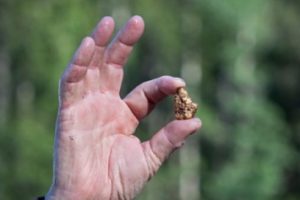Despite an absence of support from the EPA, the proposed open-pit Pebble Mine Project in Southwest Alaska refuses to die. In the latest major action, the U.S. Army Corps of Engineers (Corps) announced that it will prepare a Draft Environmental Impact Statement (DEIS) based on an application for a Clean Water Act (CWA) Section 404 (dredge and fill) permit submitted by the mining company, Pebble Limited Partnership (PLP), in December 2017. The Corps found that the application was complete in January 2018, opening the door for preparation of the DEIS.
Rich in Minerals and Salmon
According to PLP, the area containing the proposed mine site is one of the world’s richest, containing an estimated 6.5 billion tons of minerals, including 57 billion pounds (lb) of copper, 71 million ounces of gold, and 3.4 billion lb of molybdenum. The site is north of Lake Iliamna, which is about 100 miles north of Bristol Bay and within the Bristol Bay watershed. The rivers and streams feeding the bay collectively support the largest sockeye salmon population in the world. In 2017, an estimated 60 million sockeye salmon returned from the ocean to their breeding grounds. The salmon are the main component of the economy for the Native American population around Bristol Bay.
EPA’s Veto Power
The Section 404 permitting process is a joint exercise involving the Corps and the EPA. While the Corps ultimately grants and writes the permit, the EPA has CWA authority to veto any permit if a discharge from a project “will have unacceptable adverse effects on municipal water supplies, shellfish beds and fishery areas, wildlife, or recreational areas.”
In 2014, long before PLP and its parent company, Northern Dynasty Minerals of Vancouver, Canada, even submitted a Section 404 permit application, the Obama EPA completed an assessment of the project based on publicly available documents and issued a proposed determination that the envisioned project would have multiple “unacceptable” environmental and ecosystem impacts. These included “complete loss of fish habitat due to elimination, dewatering, fragmentation of streams, wetlands, and other aquatic resources. In addition, water withdrawal and capture, storage, treatment, and release of wastewater associated with the mine would significantly impair the fish habitat functions of other streams, wetlands, and aquatic resources. All of these losses would be irreversible.”
The EPA said it would only change this proposed determination if the mining companies so cut back on their mining plan that the project would likely no longer be economically feasible.
Proposed Determination Remains
Once the Trump administration took office, prospects for the mine brightened when the EPA proposed to withdraw its prior proposed determination. That second proposal generated more than a million public comments, the overwhelming majority opposing withdrawal of the determination. The EPA decided to leave the 2014 proposed determination in place.
“It is my judgment at this time that any mining projects in the region likely pose a risk to the abundant natural resources that exist there,” said EPA Administrator Scott Pruitt. “Until we know the full extent of that risk, those natural resources and world-class fisheries deserve the utmost protection.”
Reduced Mining Plan
In announcing the start of the DEIS process, the Corps indicated that the mining plan in PLP’s application is “substantially smaller” than what the company originally envisioned. The major parameters of the project as described in the application include the following:
- A 5.9-square-mile footprint (6,500 feet (ft) long by 5,500 ft wide, with depths between 1,330 and 1,750 ft), reduced from the originally planned footprint of 6.9 square miles;
- A tailings impoundment with 1.1 billion tons of storage volume;
- A low-grade ore stockpile with the capacity to store up to 330 million tons;
- An open pit overburden stockpile;
- A mill facility processing approximately 160,000 tons of ore per day;
- A natural gas-fired power plant with a total connected load of 230 megawatts, supplied by a 188-mile, 10- to 12-inch diameter natural gas pipeline across Cook Inlet and Iliamna Lake to the mine site; and
- A transportation infrastructure, including a 30-mile road from the mine site to a ferry terminal on the north shore of Iliamna Lake, an 18-mile crossing with an ice-breaking ferry to a terminal on the south shore of Iliamna Lake, and a 35-mile road to the proposed Amakdedori Port on Cook Inlet.
Alternatives Will Be Considered
Under the National Environmental Policy Act, the final EIS must include consideration of a range of alternatives, which in this case the Corps says will include but not be limited to a no-action alternative, the applicant’s proposed alternative, alternative mine locations and mine plans, alternative mining methods and processes, alternatives that may result in avoidance and minimization of impacts, and mitigation measures not in the proposed plan.
The Corps says scoping for the DEIS will be conducted from April 1, 2018, through April 30, 2018. Scoping is intended to assist in determining the scope of analysis, significant issues, and alternatives to be analyzed in depth in the DEIS.
The Corps’s announcement was published in the March 29, 2018, FR.

